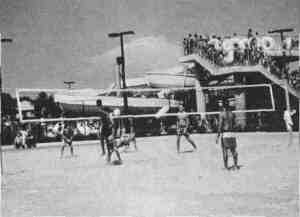by Shari Moser Ross
When the Hoffman Estates Park District board of commissioners surveyed its residents in 1993 regarding their recreational needs, an overwhelming number of respondents asked for a place for water-based recreation and expanded swimming opportunities. This northwest suburban park district had an outdated swimming pool which was too costly to renovate and relied on leased time and space at the local high school pool to conduct swim lessons and water recreation programs. Two years and 4.2 million dollars later, the Hoffman Estates Park District's Seascape Family Aquatic Center opened for business for its first summer of operation and recorded more than 90,000 user visits between June and September of 1995. Hoffman Estates is just one of many Illinois communities that, in the last five to eight years, renovated or built from the ground up a well-accepted type of aquatic facility—the leisure pool or family aquatic center. From Hoffman Estates to Lombard to Rockford, park districts have found that the traditional rectangular pool does not have the same appeal as in the past. These and other cities have found success with aquatic facilities that incorporate play areas and entertainment for all ages and ability levels, attract more users and in most cases, are more than financially self-sustaining—a feat that the traditional pool failed to accomplish.
Some of the more popular attractions that park districts are currently incorporating into renovated or newly built aquatic facilities range from the simple slide to busy water playgrounds. Waterslides come in many different shapes, sizes, lengths and styles and are a sure bet for increasing attendance numbers. Flume slides are a curved or "wavy" slide that take swimmers on a long or short maze of twists and turns before dumping them into the water. Drop slides are shorter, straighter slides that deposit swimmers not directly into the water, but into the air anywhere from 3 to 10 feet above the water, creating the sensation of a free fall before the final splash. Tube slides add the element of surprise to the ride as they are completely en-
Aquatic facilities that incorporate play areas and entertainment for all ages and ability levels, attract more users and in most cases, are more than financially self-sustaining—a feat that the traditional pool failed to accomplish.
Illinois Parks & Recreation * March/April 1996 * 47 TRENDS
closed and the swimmer can only make guesses as to when he or she will emerge from the slide and drop into the water. Water playgrounds are areas of very shallow water which may include water sprays or other interactive water features shaped like mushrooms, animals or other shapes that shoot water up and around the play area. Lazy rivers are long canals of slow-moving water, often circling an entire waterpark or aquatic center on which patrons can travel using a raft, tube or other floating device. Far and away the most popular attraction and most commonly added feature of aquatic centers over the past five years is the zero-depth entry. Appropriately named because the depth of the water literally begins at zero and gradually deepens to three, four or five feet, this attraction makes entry to the pool similar to entering a lake or ocean. Zero depth is especially popular with small children who may be more comfortable entering the pool gradually rather than jumping into three feet or more of water, and to seniors or persons with disabilities for
whom pool access via a stepladder may not be possible. While each of these aquatic attractions is geared toward a particular age or type of swimmer (drop slides for the adventurous swimmer and lazy rivers for the more passive patron), they all have one thing in common: they make the swimming pool a more entertaining place to visit. This entertainment factor helps keep both pool attendance and revenues up.
For example, an outdoor facility built by Counsilman/Hunsaker for the Granite City Park District includes some aspects of the traditional L-shaped pool like lap swimming lanes and deeper water. However, instead of a deep-end/diving well, the "L" fans out into a zero depth entry thus allowing the long lanes of the pool to be used by fitness swimmers while still providing a safer, easier entry, shallow-water alternative for children, seniors, persons with disabilities and parents watching their children at play. Flexible space is a concept that is also in place at the Lombard Park District Moran Water Park, which had been a traditional rectangular pool, was renovated in 1988, and opened with new interactive and play features in 1989. The current fa-
"The key to future success is offering family rides and attractions
that encourage interactive group activities. The inclusion of rides
allowing many users to be in the water at one time, like lazy rivers,
are also among the trends."
48 * Illinois Parks & Recreation * March/April 1996 cility combines a diving well with two one-meter boards, a 25-yard lap pool, a zero depth entry on one end, a waterfall, two waterslides, a sand volleyball court, a sand play area for tots and a large concession area. In this one facility, the park district is able to meet the aquatic needs of people of all ages, swimming ability levels, and interests. The new features at the Moran Water Park not only brought in more patrons but also helped the pool to be able to support 100% of its operational costs through daily admission fees and season passes. Park attendance grew from 26,371 visitors in 1987 to more than 63,000 visitors in 1993. Although the additional play features and renovations, along with maintenance and upkeep of the attractions, have brought greater expenses to the pool budget, total revenues have also increased over 300% since 1987.
The critical value of concessions is another point that Rogers stresses. With added water and deck attractions keeping people in the park longer and often over meal times, a well-operated concession stand with adequate lounge and eating areas can add significant revenue to a facility's budget. Dan Gundrum, manager of the Rockford Park District's Magic Waters waterpark echoes Rogers' point about concessions. Since 1988, Magic Waters has added a number of attractions from tube slides to a 1,200-foot linear lazy river and with each addition came an upgrade in the support amenities like concessions. As the park gets larger and attracts more people, the concession areas need to be equipped to handle the increase in visitors and the increase in length of time that patrons stay at the pool. Magic Waters is one of the first success stories of an Illinois park district operating a large scale waterpark. Built in 1984 by private developers and taken over by the park district in 1988, the park boasts numerous water slides and other interactive water attractions along with its lazy river and a popular wave pool. Additions of new attractions every few years have contributed to the park's continued growing attendance. Between 1990 and 1994, Magic Waters' attendance figures grew from 192,088 users to 249,021 users. These high numbers are evidence of the public's growing affection for interactive aquatic experiences rather than lap swimming. Rockford has also put its acquired knowledge of satisfying its community's aquatic needs by adding interactive water play areas and water slides to other district pools and has experienced the same increases in user visits at each of those facilities as well.
Karen Janisewski is a project designer for Water Technology, Inc., an aquatic design and engineering firm in Beaver Dam, Wisconsin, responsible for designing and building a number of successful Illinois park district facilities including Rockford's Magic Waters, a new facility at the Fox Valley Park District and a renovated facility in Homewood-Flossmoor. She believes the key to future success is offering family rides and attractions that encourage interactive group activities. The inclusion of rides allowing many users to be in the water at one time, like lazy rivers, are also among the trends Janisewski predicts for the next five to ten years.
The family aquatic center is a recreational trend that will continue to gain popularity into the 21st century. The programming variety and revenue potential that aquatic centers offer a park district continue to grow. However, as with any new project, careful planning and research must be done before undertaking any renovation or building. The help of an experienced and qualified designer, architect, builder or consultant in planning to renovate or construct a new center is imperative in ensuring the facility's success. Shari Moser Ross is the national aquatic coordinator/or the National Recreation and Park Association (NRPA). NRPA can assist communities by providing technical assistance and referrals to qualified aquatic consultants. For more information about NRPA's aquatic services, publications, education and training opportunities or other resources, call 800-677-2236.
Illinois Parks & Recreation * March/April 1996 * 49 |Home|
|Search|
|Back to Periodicals Available|
|Table of Contents|
|Back to Illinois Parks & Recreaction 1996|
|
|||||||||||||||


